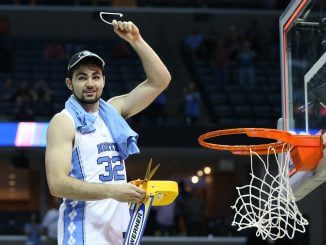
CHAPEL HILL — Every Saturday, when Larry Fedora’s offense takes the field, announcers rave about how fast things move.
“Don’t blink,” one broadcast team said earlier this year, as quarterback Nathan Elliott got everyone lined up, then looked to the sideline to get the play and shouted instructions to his teammates.
“This North Carolina team likes to move fast and wear the defense out,” the play-by-play guy said in another game, as Elliott surveyed the defense, put someone in motion, and the play clock dropped below 20 seconds.
It’s called tempo, fast-break football and a high-speed offense. Late in the second quarter of the Tar Heels’ game against Syracuse two weeks ago, the announcer raved that there wouldn’t be much difference as Carolina tried to score before the half, “because these guys run the two-minute offense all game long.”
For all the talk about Fedora’s tempo offense, the one thing no one ever seems to stop and notice one thing:
They really don’t move all that fast.
Through seven games this season, UNC’s offense has run 516 plays. That’s exactly the same number as NC State. However, a search of “Wolfpack” and “up-tempo offense” produces plenty of links to stories about basketball coach Kevin Keatts — very little in the way of football.
Wake Forest is running 12 more plays a game than the Tar Heels. Syracuse is running seven more. Boston College is running two more.
Sure, North Carolina has struggled on offense this year, turning from Elliott to Chazz Surratt and true freshman Cade Fortin as Fedora tries to find a consistent quarterback. Even in the heyday of the Fedora tempo attack, however, the Heels weren’t running anyone off the field.
In 2015, when Marquise Williams shattered just about every school record for offensive production and Carolina won the Coastal Division, the Tar Heels ran just 66 plays a game — seven fewer than this season and ninth in the ACC.
This season, on plays when the clock is running, UNC averages a snap every 29.8 seconds.
That ranks sixth in the ACC.
Seconds per play
ACC offenses
1. Wake Forest 25.0
2. Boston College 25.8
3. Syracuse 27.0
4. Duke 27.7
5. Clemson 27.8
6. North Carolina 29.8
7. Virginia Tech 30.3
8. Florida State 30.8
9. NC State 31.7
10. Georgia Tech 31.9
11. Miami 33.3
12. Louisville 33.5
13. Virginia 35.4
14. Pitt 35.6
Compared to the 2015 Coastal champions, UNC’s offense is running only about one second slower, so this isn’t a case of a less talented team putting on the brakes.
One of the benefits of running tempo is that the opponent isn’t used to it. Clemson, for instance, runs a play every 27.8 seconds, which is 7.4 seconds faster than their opponents have operated when playing the Tigers, as they likely slow things down to keep Clemson’s offense off the field.
When ranking ACC offenses by that measure, UNC again finishes in sixth place.
Seconds per play faster than opponents — ACC offenses
1. Clemson 7.4
2. Duke 6.4
3. Syracuse 5.7
4. Boston College 5.3
5. Wake Forest 5.2
6. North Carolina 2.7
7. Florida State 0.52
8. Virginia Tech 0.47
9. Miami 0.1
10. NC State -0.8 (0.8 seconds slower than opponents)
11. Virginia -1.9
12. Georgia Tech -2.2
13. Louisville -3.2
14. Pitt -6.5
So, has Fedora sold everyone a bill of goods? In the production meeting the day before a game, does he somehow convince the broadcast team to ignore the numbers — and their own eyes — perhaps through some type of hypnotic suggestion?
Not quite. It’s more likely a case of the announcing teams misunderstanding how the tempo offense works — something we’ve all done since Fedora arrived.
Early in his tenure at UNC, Fedora used the term “multi-tempo” to describe his offense — as he did when he coached at Southern Miss as well.
The Heels’ game against Virginia was a good demonstration of multi-tempo. On UNC’s early-game touchdown drive, the offense ran 11 plays in 4:23, or a snap every 23.9 seconds.
The offense struggled after that until Fedora went to up-tempo in the second quarter, which produced an eight-play, 2:31 touchdown drive, or a snap every 18.9 seconds.
“The only time we were able to dictate (things) was when we had our tempo going,” he said afterward.
In other words, it’s not about putting pedal to metal all game long. It’s about finding a speed that works.
“Tempo is about getting to the line quickly, and putting pressure on the defense,” Fedora explained midway through his first year in Chapel Hill. “It’s not about getting a certain number of snaps in a game.”
That’s something that the Tar Heels have done consistently, regardless of quarterback or win-loss record. By skipping the huddle and rushing to the line, UNC prevents opposing defenses from making substitutions and forces them to be prepared for a snap that can come at any time. The uncertainty is what puts pressure on the defense, not necessarily fast snaps.
So the next time the Tar Heels line up, and the TV crew talks about their frantic pace, keep in mind that, at high speeds, sometimes things may end up getting blurred.


